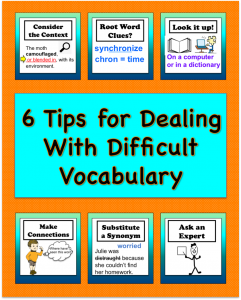 When teaching reading, especially to ELL students, I always found myself struggling to find strategies to help them understand the meaning of new or difficult vocabulary. For the purpose of this post I’m going to focus on my ELL students because they usually seemed to have the most difficulty, but I’ve always taught these strategies to all of my students. The best method I’ve found was to invite my ELL students to the back table during silent reading time when the rest of my class was reading independently. We called this intervention our “book club.”
When teaching reading, especially to ELL students, I always found myself struggling to find strategies to help them understand the meaning of new or difficult vocabulary. For the purpose of this post I’m going to focus on my ELL students because they usually seemed to have the most difficulty, but I’ve always taught these strategies to all of my students. The best method I’ve found was to invite my ELL students to the back table during silent reading time when the rest of my class was reading independently. We called this intervention our “book club.”
I would always have a text picked out ahead of time, preferably focused on the content we were studying in science or social studies. I would have the group start by reading the text silently in their heads while I read my own copy. As they read I asked them to take note of, or underline, any unfamiliar vocabulary they came across. Many times they all underlined the same words.
Next, we would go through the following steps for each word. As we went through the steps over and over again they became second nature and my students would start to use them on their own. The steps not only work for ELL students but anyone coming across difficult vocabulary in their reading.
For some colorful, printable, illustrated posters and flashcards with the strategies on them click here!
1. Use Your Memory: Have you seen or heard this word before?
There were many times when my students would say they had seen the word before on a TV show or heard me use it in a certain context. Sometimes this would give them a clue to the meaning of the word. For example: If they had heard the word on the Animal Planet TV show about dogs, the word might have something to do with dogs.
2. Think About its Context: Are there any clues in the text around the word?
Next, I would have my students see if they could find any contextual clues to help them figure out the meaning of the word. I would teach them that sometimes the clue wasn’t in the exact sentence but it could be somewhere else on the page so they had to look hard.
3. Substitute a Synonym: Can you replace the word with another word that makes sense? This strategy, combined with the previous two, worked the majority of the time. Students would try replacing the word with one they thought meant the same thing and many times it did.
Students could figure out the meaning of many difficult words just using the first 3 steps. Sometimes they would still have trouble so I taught them these additional steps as a way to find the meaning of the word but we wouldn’t always need to use them.
4. Look at its structure: Does it have any familiar prefixes or suffixes?
I would teach my students to look at the structure of the word and take note of any prefixes or suffixes on it that they might know the meaning of. Sometimes this would give them a clue to its meaning. Also, if they removed the prefix or suffix they might recognize the meaning of the root word by itself.
5. Look it up: Can you find it in the dictionary?
Sometimes it was necessary to look the word up in the dictionary, or for a class with easy access to technology, they could look the word up on a website like dictionary.
6. Ask an expert: Is there someone you can ask who might know its meaning?
Many times this is where I would step in to help. When working with my ELL students I would find myself drawing or acting out the word to help them understand it.
Once I realized how powerful these strategies were I made a set of posters to post on my wall for students to refer to until they had the steps memorized. I also created them into a smaller set of cards that students could keep with them or take home for a quick reference when struggling with difficult words.
